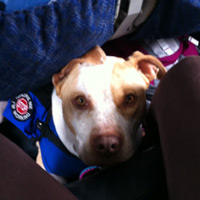Written by Nerissa Cannon
Originally posted April 21, 2016
Although one typically sees Golden Retrievers, Labrador Retrievers, and German Shepherd Dogs used as service dogs, in the United States of America there is no restriction on what breed of dog a disabled individual can use to mitigate their disability. What is required is that the dog’s size be appropriate to the tasks it performs. A service dog may come from a litter specifically bred to work for/with people, or be rescued from an animal shelter. While I hesitate to speak on behalf of all the service dog community, I believe most would agree with me that it’s more important to get a dog with a drive to work, than to focus on a specific breed you have in mind. But what happens if the dog that you find works best for you is on banned breed lists all over the world? I unwittingly found myself in this very situation.
I brought Cash into my life the day he turned 5 months old.
Having struggled with my mental health for a good while at that point, he was intended to be a hiking companion and the equivalent of an emotional support animal at home (though at that time I didn’t know the legal terminology). Cash was not intended to be a service dog, as I didn’t even know how one would be trained to help a person with mental illness. I brought him into my life knowing that a lot of people were afraid of pit bulls and bully breed mixes, but not knowing the vast amount of prejudice and laws that exist to restrict their presence. When I learned how dogs could be trained to assist those with mental illness, and I saw what a great temperament Cash had, I embarked on his service dog journey quite naively.
Being new in the service dog world, I reached out to a few programs that would perform a public access test for an owner-trained Service Dog and offer a certificate to prove a certain level of training. Time and time again, I was turned down from these organizations because “due to liability [they would] not certify a pit bull.” In hindsight, I’m grateful they rejected us. It would have been a complete waste of money since the Americans with Disabilities Act (ADA) doesn’t require any certification for service dogs. However, at the time I was upset and didn’t understand why they could legally refuse my dog as a service dog if the ADA didn’t. Enter the world of insurance companies.
Insurance exists in just about every part of our lives.
Car insurance, homeowner’s insurance, renter’s insurance, our landlord has insurance for his properties, and more! Most dog training businesses are expected to have a certain level of insurance as well. Because insurance companies are in the business of evaluating risk, most include a list of dog breeds they won’t cover at all, or they will cover but at extremely high premiums. Believe it or not, it’s not just bully breeds insurance companies blacklist. American Pit Bull Terriers, Rottweilers, German Shepherds, Huskies, Malamutes, and Dobermans are just a few of the breeds insurance companies often deem “dangerous.” (Editor’s note: State Farm and Farmers Insurance both evaluate whether to insure dogs based on whether they have a bite history, not based on their breed.)
What does insurance coverage mean for Service Dog teams? Well, if an individual is using a Service Dog, they are disabled. Many people are unable to work full-time, and are on extremely limited income, and therefore may require subsidized housing. If the housing development they apply to doesn’t allow pets, they should still be allowed to have their Service Animal with them under the Fair Housing Act (FHA). However, when you request to have your Service Animal with you under the FHA, you are requesting “reasonable accommodation” of the housing company. If the insurance company the development is using restricts or has extremely high premiums for your Service Dog’s breed, then the housing company is legally allowed to refuse that accommodation. Expecting the housing company to pay ridiculous rates for insurance just for you to live there is not considered “reasonable accommodation.” This is an unfortunate truth and something everyone who is considering using a “restricted” breed as a Service Dog should consider.
Now, let’s say you enjoy traveling! Many disabled individuals enjoy travelling to new places, but we also must be mindful of local laws as we travel, especially if the breed of dog we use as a service dog is listed in breed specific legislation (BSL). In the USA, while it’s important to be mindful of where pet dogs are banned under BSL, the American’s with Disabilities Act nonetheless requires service dog handlers to be granted access regardless of breed restricting laws.
“A service animal may not be excluded based on assumptions or stereotypes about the animal’s breed or how the animal might behave.”
ADA: Q&A #23
(https://www.ada.gov/regs2010/service_animal_qa.html#bre)
Living in Colorado, Cash and I have travelled more than once through Denver where there is heavy breed specific legislation, not just in Denver County, but in many of the surrounding counties. We have even visited Denver Zoo! I am happy to report, that I never received any access issues or inconsiderate behavior during these trips. I’m always prepared with education materials in the event someone does give us a challenge, but so far everyone has respected that Cash is trustworthy and just there to do a job for me.
If Cash and I were to venture beyond USA borders, however, the story would be very different. Even with our border neighbors, Canada, Cash’s breed is banned in virtually all areas, even as a service dog. Travelling across the oceans usually means a team would have to be certified by an ADI (Assistance Dogs International) program. Most ADI programs don’t have owner-trainer programs. The few that do often don’t accept APBTs (American Pit Bull Terriers) or bully breed mixes. Even if they did, APBTs and bully breed mixes, even as service dogs, are banned in many countries, including France, Great Britain, Germany, Australia, and more! And it’s not just “bully breeds.” Many European countries have “dangerous dog” lists that extend the ban to even more breeds, whether or not it’s an ADI certified service dog. Long story short, if you want to travel outside of the country with your service dog, you might want to consider a breed that’s not on these lists unless you are comfortable with leaving your medical equipment behind.
Some counties in the USA require certain breeds be muzzled when out in public.
Similar to leash laws, unless this law interferes with the service dog’s task work (per ADA law), you are required to follow it. Many European airlines even require program certified assistance dogs to be muzzled in flight. Are you willing to muzzle your service dog?
On top of all the legalities of having a restricted breed as a service dog, you must be willing to endure the fear of the general public.
Personally, it breaks my heart when people skirt away from me for fear of my sweet boy. I’ve had people halt their bikes on a sidewalk, refusing to pass until they’ve watched me walk “the pit bull” away. It’s devastating. Ultimately, I’m willing to endure the hardships because the positives Cash adds to my life exceed the drawbacks. However, for some people the anxiety of handling a restricted breed as a service dog would make their disability more difficult to handle, and that is a consideration worth taking into account.










